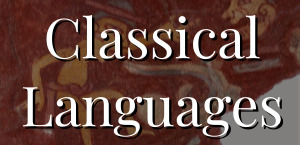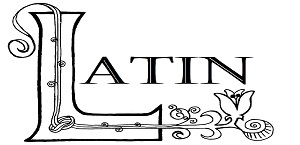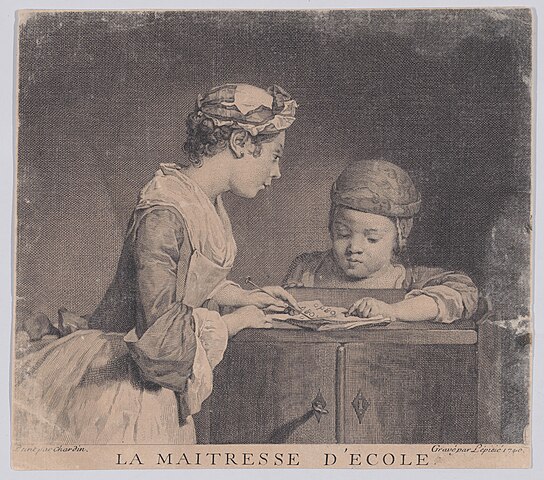

The study of Latin is a wonderful way to teach advanced grammar skills—the first leg of the mediaeval trivium. No less importantly, it opens up the student to the living language of the Church and Her vast library of contributing authors. Students begin to learn Latin grammar; review and reinforce English grammar; memorize prayers; complete basic translations and compositions.
- Teacher: Mrs. Maren Sang

The study of Latin is a wonderful way to teach advanced grammar skills—the first leg of the mediaeval trivium. No less importantly, it opens up the student to the living language of the Church and Her vast library of contributing authors. Students cover the first 32 lessons of Benjamin D’Ooge’s Latin for Beginners; memorize 20 prayers; complete 20 translations and compositions.
Grammar includes the following:
Principles of Grammar; First and Second Declensions; Agreement of Adjectives; Possessive Adjective Pronouns; All Cases; The Nine Irregular Adjectives; The Demonstrative is, ea, id; Conjugation: Present, Imperfect, Future, Perfect, Pluperfect, and Future Perfect of sum, and 4 regular conjugations (active and passive); and more!
Translation assignments are available from all three time periods—ancient, medieval, and modern—which will allow students to pick works that complement their Traditio Nostra readings.
- Teacher-Author: Mrs. Alecia Rolling
- Teacher: Mrs. Rebecca Beaucourt

Continuing the pursuit of grammatical excellence and Catholic literacy, the students cover lessons 33 through 69 of Benjamin D’Ooge’s Latin for Beginners. And again cover twenty prayers, translations, and compositions.
Grammar includes the following:
Passive Perfect, Pluperfect, and Future Perfect; Yes-or-no Questions; Accusative Subject of an Infinitive; The Relative and Interrogative Pronoun; Third-Fifth Declensions; Expressions of Place; Ablative of Time; Pronouns: Personal and Reflexive; The Intensive Pronoun Ipse; The Demonstrative Pronoun idem; The Demonstratives hic, iste, ille; The Indefinite Pronouns; Comparison of Adjectives; Deponent Verbs; The Subjunctive Mood; Inflection of the Present, Imperfect, Perfect, Future Perfect Subjunctive; The Subjunctive of Purpose, Result, and Characteristic; Substantive Clauses of Purpose; Verbs of Fearing; The Participles; Ablative Absolute; and more!
Translation assignments are available from all three time periods—ancient, medieval, and modern—which will allow students to pick works that complement their Traditio Nostra readings.
- Teacher: Mr. Joshua Keatley

There are two semester courses required to complete this option. The courses are offered to meet the needs of students who are interested in learning a reading knowledge of Latin. Emphasis is placed on vocabulary, grammar, and sight reading in the first semester (LATN-1000). In the second semester (LATN-1020), the emphasis is on extensive Latin reading.
Additional Course Information: Offered through Oxrose Academy as an Advanced College Credit option with Benedictine College and is meant for students enrolled at Oxrose Academy. Each semester course is taught with both synchronous and asynchronous components. Live Classes are synchronous and have specific meeting times. The asynchronous components are accessed via an online portal and include video lectures that present content, automated quizzes, homework uploads, and daily work assignments.
Grammar includes the following in addition to review of grammar taught in Latin 1 and Latin 2:
Construction with cum; Ablative of Specification; Gerund and Gerundive; Predicate Genitive; Indirect Statements; Dative with Compounds; Subjunctive in Indirect Questions; Dative of Purpose or End for Which; Genitive and Ablative of Quality or Description; and more!
- Teacher-Author: Mrs. Alecia Rolling

This is an advanced readings course in the Latin language that builds upon previous years of study. Students will continue to practice and develop reading techniques which will aid them in the comprehension of Latin texts. The readings for this cycle include both classical and medieval authors important to the medieval period, such as Virgil, Livy, St. Augustine, St. Patrick, Juvencus, St. Ambrose, Prudentius, Boethius, Venerable Bede, Alcuin, Peter Damian, Hildegard von Bingen, St. Thomas Aquinas, and others.
Since students have already been introduced to the grammar of the Latin language, the focus of the class will be upon reading proficiency. Latin, like all other languages, uses syntactical patterns through which an author communicates the intended meaning. Teaching students to recognize these patterns is the goal of the course, and it greatly aids them in comprehending the language.
There can be no doubt as to the formative and educational value either of the language of the Romans or of great literature generally. It is a most effective training for the pliant minds of youth. It exercises, matures and perfects the principal faculties of mind and spirit. It sharpens the wits and gives keenness of judgment. It helps the young mind to grasp things accurately and develop a true sense of values. It is also a means for teaching highly intelligent thought and speech. (Veterum Sapientia – On the Promotion of the Study of Latin, Pope John XXIII, 1962).
- Teacher-Author: Mrs. Alecia Rolling

- Teacher-Author: Mrs. Alecia Rolling